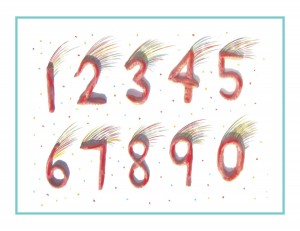Day 5
For one year, 365 days, this blog will address the Common Core Standards from the perspective of creating an alternate, ambient learning environment for math. Ambient is defined as “existing or present on all sides, an all-encompassing atmosphere.” And ambient music is defined as: “Quiet and relaxing with melodies that repeat many times.”
Why ambient? A math teaching style that’s whole and all encompassing, with themes that repeat many times through the years, is most likely to be effective and successful. Today’s blog will focus on the Kindergarten standard 5 in Counting and Cardinality. Note that the Common Core Standards will appear in blue, followed by an ambient translation.
Counting and Cardinality K.CC
Count to tell the number of objects.
5. Count to answer “how many?” questions about as many as 20 things arranged in a line, a rectangular array, or a circle, or as many as 10 things in a scattered configuration; given a number from 1-20, count out that many objects.
I’m imagining a workbook or worksheet, with the objects displayed in a similar manner as described above. And the question arises: Do worksheets belong in Kindergarten? If we come from a perspective of more healthy play and movement than academic abstraction, the answer is decidedly no.
Now regarding the question of waking up the intellect too early, it gets even trickier. Let’s see how playful and moving this can be! Access the concept of number and value by using visual counters that represent the numbers (echoing yesterdays number jar activity), thus conveying the essence of each number tactilely and visually, without being too abstract.

Create counting stones like those pictured above and store them in baskets, available for play anytime. For this activity use blank stones to create the arrays described in Standard 5, then have the counting stones visible when you ask how many in an array, so the correct stone can be pointed to as the number is said.
For more gross motor movement, draw 10 circles on the ground or cut out 10 construction paper circles and place them on the floor in the arrays described in Standard 5, and have the child(ren) jump from one to the other as they count. Again, have the counting stones handy for reference. Or use yesterday’s number jars to count up to 20.
Have the child(ren) say/sing the counting verse: One, Two, Buckle My Shoe while jumping the circles up to 10 or 20.
1-2 buckle my shoe,
3-4 knock at the door,
5-6 pick up sticks,
7-8 lay them straight,
9-10, a big fat hen,
11-12, dig and delve,
13-14, who’s a’ courting,
15-16, who’s in the kitchen,
17-18, who’s a waiting,
19-20, my platter’s empty
Always keep it lively, and remember that knowledge ensues in an environment dedicated to imaginative, creative knowing, where student and teacher alike surrender to the ensuing of that knowledge as a worthy goal. More Kindergarten tomorrow!












